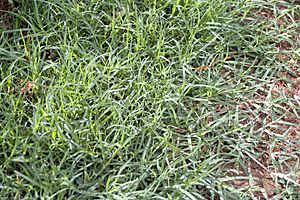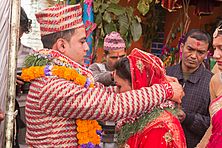Bermuda grass facts for kids
Quick facts for kids Bermuda grass |
|
|---|---|
 |
|
| Scientific classification | |
| Genus: |
Cynodon
|
| Species: |
dactylon
|
| Synonyms | |
|
List
|
|
Cynodon dactylon, known as Bermuda grass, Dhoob, dūrvā grass, ethana grass, dubo, dog grass, dog's tooth grass, Bahama grass, crab grass, devil's grass, couch grass, Indian doab, arugampul, grama, wiregrass and scutch grass, is a grass found worldwide. It is native to Europe, Africa, Australia and much of Asia. It has been introduced to the Americas. Although it is not native to Bermuda, it is an abundant invasive species there. In Bermuda it has been known as "crab grass" (also a name for Digitaria sanguinalis).
Contents
Description
The blades are a grey-green colour and are short, usually 2–15 cm (0.79–5.91 in) long with rough edges. The erect stems can grow 1–30 cm (0.39–11.81 in) tall. The stems are slightly flattened, often tinged purple in colour.
The seed heads are produced in a cluster of two to six spikes together at the top of the stem, each spike 2–5 cm (0.79–1.97 in) long.
It has a deep root system; in drought situations with penetrable soil, the root system can grow to over 2 metres (6.6 ft) deep, though most of the root mass is less than 60 centimetres (24 in) under the surface. The grass creeps along the ground with its stolons, and roots wherever a node touches the ground, forming a dense mat. C. dactylon reproduces through seeds, stolons, and rhizomes. Growth begins at temperatures above 15 °C (59 °F) with optimum growth between 24 and 37 °C (75 and 99 °F); in winter, the grass becomes dormant and turns brown. Growth is promoted by full sun and retarded by full shade, e.g., close to tree trunks.
Cultivation
Cynodon dactylon is widely cultivated in warm climates all over the world between about 30° S and 30° N latitude, and that get between 625 and 1,750 mm (24.6 and 68.9 in) of rainfall a year (or less, if irrigation is available). For example, it is grown in the U.S. mostly in the southern half of the country.
Cultivars
Hundreds of cultivars have been created specifically for environmental tolerance and stakeholder requirements. New cultivars are released yearly.
Uses
Religious
Commonly known as "durva" or dūrvāyugma in India, this grass is used in the Ayurveda system of medicine. In Hinduism, it is considered important in the worship of Lord Ganesha. A clump of 21 shoots of this grass is usually offered during the pooja ceremony. It has been a part of Hindu rituals since Vedic times. A unique festival called Durva Ashtami, dedicated to this grass, is celebrated on the 8th day of Shukla Paksha of Bhadra month of the Hindu calendar.
It is known as "Karuka" in Malayalam and is part of the Dashapushpam (Ten sacred flowers) in Kerala.
In Nepal, the grass is known as dubo in Nepali and is used for worshipping rituals by the Hindus. According to Nepalese Hindus, the grass symbolises long life. The grass is an essential item for Naga Panchami festival as well as in Gaura festival. In Nepalese Khas Hindu wedding, a garland made up of the grass is worn by both bride and the groom.
This grass is a Yoruba herb used for Esu or Elegba in the Ifá Orisa System.
Medicinal value
The rhizomes are reported to act as a diuretic in humans and the grass juice can act as an astringent.
It has been observed that Cynodon dactylon may be selectively eaten by dogs to swiftly induce vomiting when they have gastrointestinal problems. The effect may be due to irritation caused by bristles on the leaf margin.
Other
It is fast-growing and tough, making it popular and useful for sports fields, as when damaged it will recover quickly. It is a highly desirable turf grass in warm temperate climates, particularly for those regions where its tolerance to heat and drought enable it to survive where few other grasses do. This combination makes it a frequent choice for golf courses in the southern, southeastern U.S and South Africa. It has a relatively coarse-bladed form with numerous cultivars selected for different turf requirements.
Bermuda grass has been cultivated in saline soils in California's Central Valley, which are too salt-damaged to support agricultural crops; it was successfully irrigated with saline water and used to graze cattle.
NFL Playing Surfaces
- State Farm Stadium in Glendale, AZ (Tifway 419 Hybrid Bermudagrass)
- M&T Bank Stadium in Baltimore, MD (Tifway 419 Bermudagrass)
- Arrowhead Stadium in Kansas City, MO (Latitude 36 Bermuda Grass)
- FedEx Field in Landover, MD (Latitude 36 Bermuda Grass)
- Nissan Stadium in Nashville, TN (Tifsport Bermuda Sod)
- Allegiant Stadium in Paradise, NV
- Levi's Stadium in Santa Clara, CA (Tifway II Bermuda Grass)
- TIAA Bank Field in Jacksonville, FL (Tifway 419 Bermudagrass)
- Hard Rock Stadium in Miami, FL (Tifway 419 Bermudagrass)
- Raymond James Stadium in Tampa, FL (Tifway 419 Bermudagrass)
- Soldier Field in Chicago, IL (Tahoma 31 Bermudagrass)
MLB Playing Surfaces
- Angel Stadium in Anaheim, CA (Tifway 419 Bermudagrass)
- Dodger Stadium in Los Angeles, CA (Santa Ana Bermudagrass)
- Oakland Coliseum in Oakland, CA (Tifway II Bermuda Grass)
- Petco Park in San Diego, CA (BullsEye Bermuda Grass)
- Oracle Park in San Francisco, CA (Tifway 419 Bermudagrass)
Ecology
Invasive species
It is a highly aggressive invasive species, crowding out most other grasses and invading other habitats, and has become a hard-to-eradicate weed in some areas (it can be controlled somewhat with Triclopyr, Mesotrione, Fluazifop-P-butyl, and Glyphosate). This weedy nature leads some gardeners to give it the name of "devil grass". Bermuda grass is incredibly difficult to control in flower beds and most herbicides do not work. However, Ornamec, Ornamec 170, Turflon ester (tricyclopyr), and Imazapyr have shown some effectiveness. All of these items are difficult to find in retail stores, as they are primarily marketed to professional landscapers.
The hybrid variety Tifton 85, like some other grasses (e.g. sorghum), produces cyanide under certain conditions, and has been implicated in several livestock deaths.
See also
 In Spanish: Grama común para niños
In Spanish: Grama común para niños





